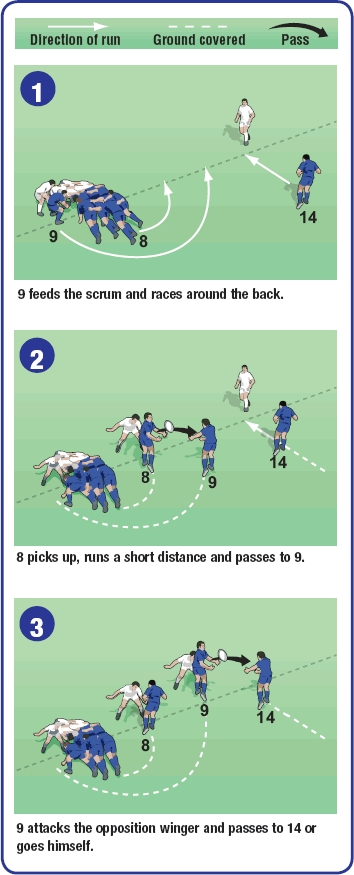You are viewing
1 of your 2 free articles
Back row moves
Backs Movesby Dan Cottrell
Why this move works
- From a scrum with a 15 metre or greater blindside, a swift 8 and 9 can quickly get into the space between the scrum and normally the lone defender.
- 8's run draws a back row defender to create a 2 v 1 for your 9 and 14. With the defending 15 likely to be covering the midfield, this may give 14 a free run to the line.
- A quick 8 who can pass well.
- A quick 9 who can attack gaps.
- A fast 14.
- A scrum that can wheel slightly so the tighthead side gets ahead of the loosehead.

What players should do in this rugby drill
- As soon as the ball is at his feet, 8 picks and goes right. He passes to 9 as that player comes round.
- 9 puts the ball into the scrum, then arcs round the back of it and to the right. He takes a pass from 8 and attacks the inside shoulder of the opposition 11.
- If the opposition 11 is drawn in, 9 passes to 14. Otherwise 9 continues his run.
- 14 stands close to the touchline. He waits until 9 receives the ball before running forwards to support 9, possibly to take the pass.
- The scrum wheels the wrong way, so 8 has a long way to go to attack. In which case cancel the call.
- 8 runs too far with the ball.
- 14 stands too close or runs too early. He must maintain his position to keep his marker guessing.
- 14 looking to switch with 9.
- 9 kicking ahead for 14, especially if the opposition has put another defender on the blindside.
Click here for rugby coaching tips to train your back row.
Newsletter Sign Up
Coaches Testimonials

Gerald Kearney, Downtown Las Vegas Soccer Club

Paul Butler, Florida, USA

Rick Shields, Springboro, USA

Tony Green, Pierrefonds Titans, Quebec, Canada
Subscribe Today
Be a more effective, more successful rugby coach
In a recent survey 89% of subscribers said Rugby Coach Weekly makes them more confident, 91% said Rugby Coach Weekly makes them a more effective coach and 93% said Rugby Coach Weekly makes them more inspired.
Get Weekly Inspiration
All the latest techniques and approaches
Rugby Coach Weekly offers proven and easy to use rugby drills, coaching sessions, practice plans, small-sided games, warm-ups, training tips and advice.
We've been at the cutting edge of rugby coaching since we launched in 2005, creating resources for the grassroots youth coach, following best practice from around the world and insights from the professional game.
More from us
© 2023 Rugby Coach Weekly
Part of Green Star Media Ltd. Company number: 3008779
We use cookies so we can provide you with the best online experience. By continuing to browse this site you are agreeing to our use of cookies. Click on the banner to find out more.













